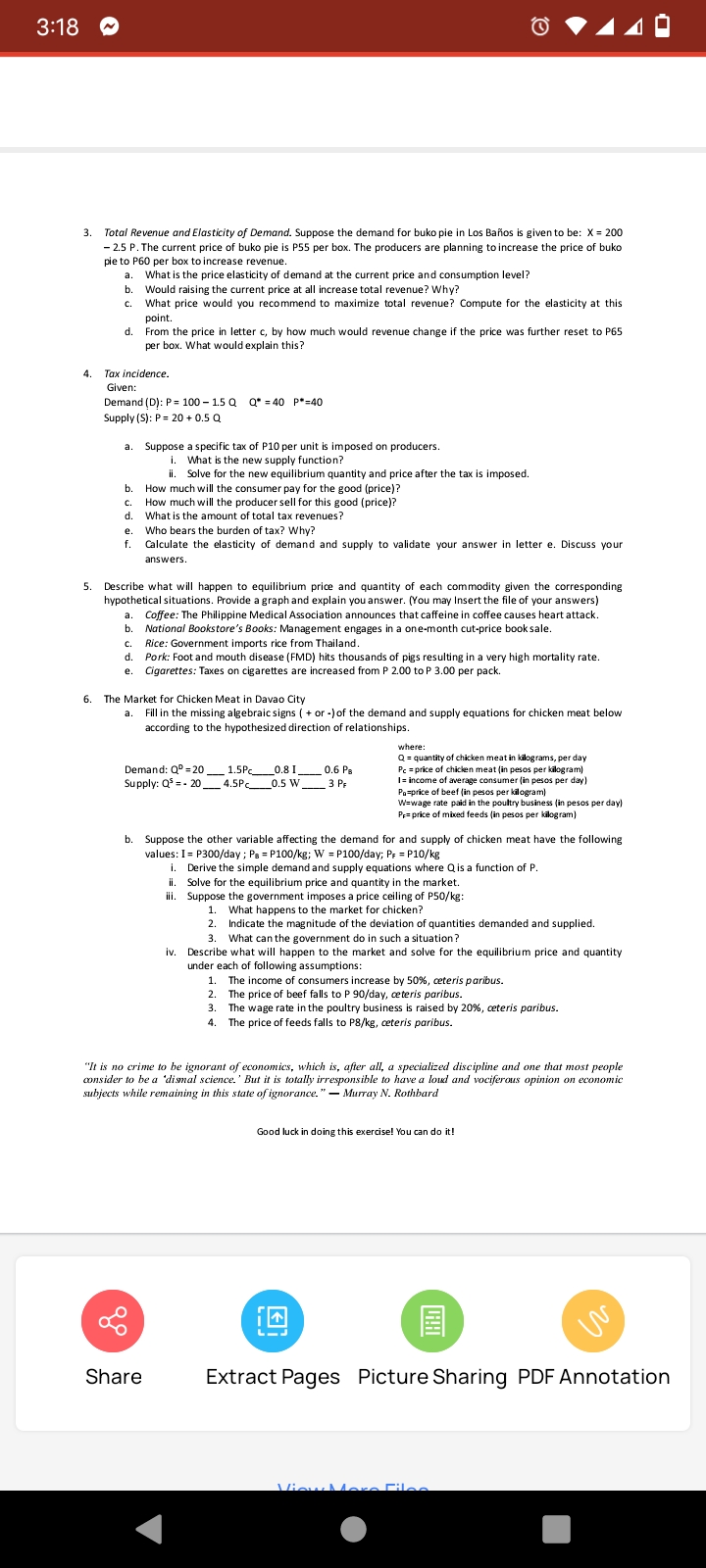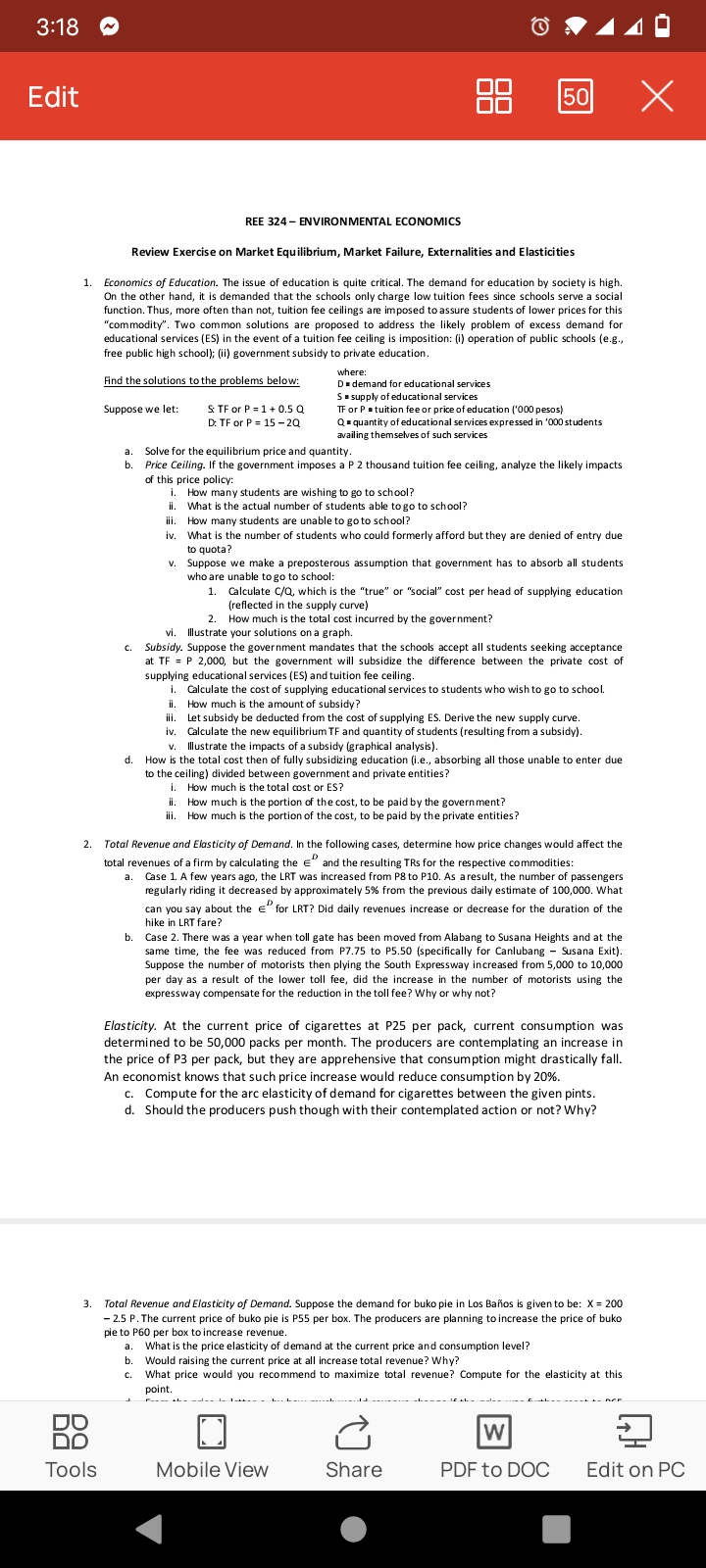3. Total Revenue and Elasticity of Demand. Suppose the demand for buko pie in Los Baños is given to be: X = 200 -2.5 P. The current price of buko pie is P55 per box. The producers are planning to increase the price of buko pie to P60 per box to increase revenue. a. What is the price elasticity of demand at the current price and consumption level? b. Would raising the current price at all increase total revenue? Why? c. What price would you recommend to maximize total revenue? Compute for the elasticity at this point.
3. Total Revenue and Elasticity of Demand. Suppose the demand for buko pie in Los Baños is given to be: X = 200 -2.5 P. The current price of buko pie is P55 per box. The producers are planning to increase the price of buko pie to P60 per box to increase revenue. a. What is the price elasticity of demand at the current price and consumption level? b. Would raising the current price at all increase total revenue? Why? c. What price would you recommend to maximize total revenue? Compute for the elasticity at this point.
Principles of Economics, 7th Edition (MindTap Course List)
7th Edition
ISBN:9781285165875
Author:N. Gregory Mankiw
Publisher:N. Gregory Mankiw
Chapter11: Public Goods And Common Resources
Section: Chapter Questions
Problem 2PA
Related questions
Question

Transcribed Image Text:3:18
O
3.
Total Revenue and Elasticity of Demand. Suppose the demand for buko pie in Los Baños is given to be: X = 200
-2.5 P. The current price of buko pie is P55 per box. The producers are planning to increase the price of buko
pie to P60 per box to increase revenue.
a.
What is the price elasticity of demand at the current price and consumption level?
b.
Would raising the current price at all increase total revenue? Why?
C
What price would you recommend to maximize total revenue? Compute for the elasticity at this
point.
d
From the price in letter c, by how much would revenue change if the price was further reset to P65
per box. What would explain this?
4. Tax incidence.
Given:
Demand (D): P= 100-1.5 Q Q = 40 P*=40
Supply (S): P = 20+ 0.5 Q
Suppose a specific tax of P10 per unit is imposed on producers.
i.
What is the new supply function?
ii
Solve for the new equilibrium quantity and price after the tax is imposed.
b.
How much will the consumer pay for the good (price)?
C.
How much will the producer sell for this good (price)?
d.
What is the amount of total tax revenues?
e.
Who bears the burden of tax? Why?
f. Calculate the elasticity of demand and supply to validate your answer in letter e. Discuss your
answers.
5.
Describe what will happen to equilibrium price and quantity of each commodity given the corresponding
hypothetical situations. Provide a graph and explain you answer. (You may Insert the file of your answers)
a. Coffee: The Philippine Medical Association announces that caffeine in coffee causes heart attack.
b National Bookstore's Books: Management engages in a one-month cut-price book sale.
C.
Rice: Government imports rice from Thailand.
d. Pork: Foot and mouth disease (FMD) hits thousands of pigs resulting in a very high mortality rate.
e Cigarettes: Taxes on cigarettes are increased from P 2.00 to P 3.00 per pack.
6. The Market for Chicken Meat in Davao City
a
Fill in the missing algebraic signs (+ or -) of the demand and supply equations for chicken meat below
according to the hypothesized direction of relationships.
where:
Demand: Q=20 1.5P 0.8 I
Supply: Q² = -20____ 4.5Pc______0.5 W
0.5 W
0.6 PB
3 P
Q = quantity of chicken meat in kilograms, per day
Pc =price of chicken meat (in pesos per kilogram)
I= income of average consumer (in pesos per day)
Pa-price of beef (in pesos per kilogram)
W-wage rate paid in the poultry business (in pesos per day)
P=price of mixed feeds (in pesos per kilogram)
b.
Suppose the other variable affecting the demand for and supply of chicken meat have the following
values: I = P300/day; Ps = P100/kg; W = P100/day; PF = P10/kg
i. Derive the simple demand and supply equations where Q is a function of P.
ii. Solve for the equilibrium price and quantity in the market.
iii. Suppose the government imposes a price ceiling of P50/kg:
1. What happens to the market for chicken?
2. Indicate the magnitude of the deviation of quantities demanded and supplied.
3.
What can the government do in such a situation?
iv. Describe what will happen to the market and solve for the equilibrium price and quantity
under each of following assumptions:
1. The income of consumers increase by 50%, ceteris paribus.
2. The price of beef falls to P 90/day, ceteris paribus.
3. The wage rate in the poultry business is raised by 20%, ceteris paribus.
4. The price of feeds falls to P8/kg, ceteris paribus.
"It is no crime to be ignorant of economics, which is, after all, a specialized discipline and one that most people
consider to be a 'dismal science. But it is totally irresponsible to have a loud and vociferous opinion on economic
subjects while remaining in this state of ignorance." - Murray N. Rothbard
Good luck in doing this exercise! You can do it!
↑
國
LIJ
Share
Extract Pages Picture Sharing PDF Annotation
View More Files
w

Transcribed Image Text:3:18
Edit
X
50
REE 324 - ENVIRONMENTAL ECONOMICS
Review Exercise on Market Equilibrium, Market Failure, Externalities and Elasticities
1.
Economics of Education. The issue of education is quite critical. The demand for education by society is high.
On the other hand, it is demanded that the schools only charge low tuition fees since schools serve a social
function. Thus, more often than not, tuition fee ceilings are imposed to assure students of lower prices for this
"commodity". Two common solutions are proposed to address the likely problem of excess demand for
educational services (ES) in the event of a tuition fee ceiling is imposition: (i) operation of public schools (e.g.,
free public high school); (ii) government subsidy to private education.
where:
Find the solutions to the problems below:
D=demand for educational services
S = supply of educational services
Suppose we let:
S: TF or P = 1 + 0.5 Q
D: TF or P = 15-2Q
TF or P = tuition fee or price of education ('000 pesos)
Q=quantity of educational services expressed in '000 students
availing themselves of such services
a. Solve for the equilibrium price and quantity.
b
Price Ceiling. If the government imposes a P 2 thousand tuition fee ceiling, analyze the likely impacts
of this price policy:
i. How many students are wishing to go to school?
ii
What is the actual number of students able to go to school?
ili
How many students are unable to go to school?
iv.
What is the number of students who could formerly afford but they are denied of entry due
to quota?
V.
Suppose we make a preposterous assumption that government has to absorb all students.
who are unable to go to school:
1.
Calculate C/Q, which is the "true" or "social" cost per head of supplying education
(reflected in the supply curve)
2.
How much is the total cost incurred by the government?
vi
Illustrate your solutions on a graph.
C.
Subsidy. Suppose the government mandates that the schools accept all students seeking acceptance
at TF = P 2,000, but the government will subsidize the difference between the private cost of
supplying educational services (ES) and tuition fee ceiling.
i. Calculate the cost of supplying educational services to students who wish to go to school.
ii. How much is the amount of subsidy?
iii. Let subsidy be deducted from the cost of supplying ES. Derive the new supply curve.
iv. Calculate the new equilibrium TF and quantity of students (resulting from a subsidy).
v. Illustrate the impacts of a subsidy (graphical analysis).
d.
How is the total cost then of fully subsidizing education (i.e., absorbing all those unable to enter due
to the ceiling) divided between government and private entities?
i.
How much is the total cost or ES?
ii.
How much is the portion of the cost, to be paid by the government?
iii. How much is the portion of the cost, to be paid by the private entities?
2.
Total Revenue and Elasticity of Demand. In the following cases, determine how price changes would affect the
total revenues of a firm by calculating the and the resulting TRs for the respective commodities:
a. Case 1. A few years ago, the LRT was increased from P8 to P10. As a result, the number of passengers
regularly riding it decreased by approximately 5% from the previous daily estimate of 100,000. What
can you say about the € for LRT? Did daily revenues increase or decrease for the duration of the
hike in LRT fare?
b.
Case 2. There was a year when toll gate has been moved from Alabang to Susana Heights and at the
same time, the fee was reduced from P7.75 to P5.50 (specifically for Canlubang - Susana Exit).
Suppose the number of motorists then plying the South Expressway increased from 5,000 to 10,000
per day as a result of the lower toll fee, did the increase in the number of motorists using the
expressway compensate for the reduction in the toll fee? Why or why not?
Elasticity. At the current price of cigarettes at P25 per pack, current consumption was
determined to be 50,000 packs per month. The producers are contemplating an increase in
the price of P3 per pack, but they are apprehensive that consumption might drastically fall.
An economist knows that such price increase would reduce consumption by 20%.
c. Compute for the arc elasticity of demand for cigarettes between the given pints.
d. Should the producers push though with their contemplated action or not? Why?
3. Total Revenue and Elasticity of Demand. Suppose the demand for buko pie in Los Baños is given to be: X = 200
-2.5 P. The current price of buko pie is P55 per box. The producers are planning to increase the price of buko
pie to P60 per box to increase revenue.
What is the price elasticity of demand at the current price and consumption level?
b. Would raising the current price at all increase total revenue? Why?
C.
What price would you recommend to maximize total revenue? Compute for the elasticity at this
point.
Ĉ
W
Mobile View
Share
PDF to DOC Edit on PC
DO
DO
Tools
Expert Solution
This question has been solved!
Explore an expertly crafted, step-by-step solution for a thorough understanding of key concepts.
This is a popular solution!
Trending now
This is a popular solution!
Step by step
Solved in 3 steps

Knowledge Booster
Learn more about
Need a deep-dive on the concept behind this application? Look no further. Learn more about this topic, economics and related others by exploring similar questions and additional content below.Recommended textbooks for you

Principles of Economics, 7th Edition (MindTap Cou…
Economics
ISBN:
9781285165875
Author:
N. Gregory Mankiw
Publisher:
Cengage Learning

Essentials of Economics (MindTap Course List)
Economics
ISBN:
9781337091992
Author:
N. Gregory Mankiw
Publisher:
Cengage Learning

Principles of Economics (MindTap Course List)
Economics
ISBN:
9781305585126
Author:
N. Gregory Mankiw
Publisher:
Cengage Learning

Principles of Economics, 7th Edition (MindTap Cou…
Economics
ISBN:
9781285165875
Author:
N. Gregory Mankiw
Publisher:
Cengage Learning

Essentials of Economics (MindTap Course List)
Economics
ISBN:
9781337091992
Author:
N. Gregory Mankiw
Publisher:
Cengage Learning

Principles of Economics (MindTap Course List)
Economics
ISBN:
9781305585126
Author:
N. Gregory Mankiw
Publisher:
Cengage Learning

Principles of Microeconomics (MindTap Course List)
Economics
ISBN:
9781305971493
Author:
N. Gregory Mankiw
Publisher:
Cengage Learning

Principles of Microeconomics
Economics
ISBN:
9781305156050
Author:
N. Gregory Mankiw
Publisher:
Cengage Learning

Exploring Economics
Economics
ISBN:
9781544336329
Author:
Robert L. Sexton
Publisher:
SAGE Publications, Inc